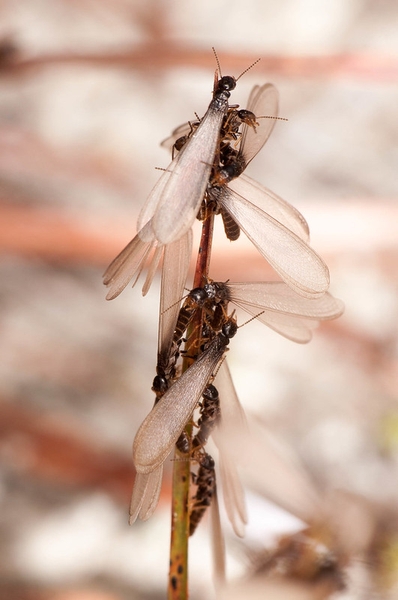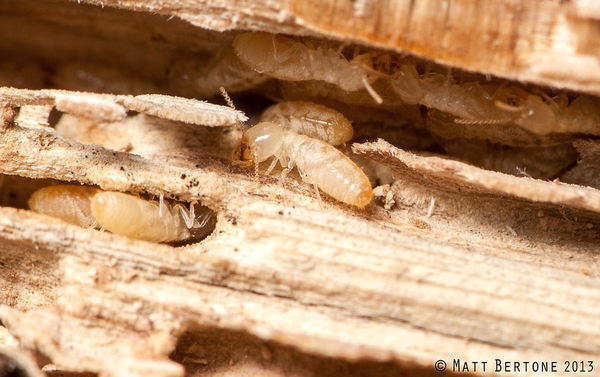Introduction
At certain times of the year, termite colonies produce “swarmers”, the winged, reproductive adults (Figure 1) that fly away to mate and form their own colonies. Swarming usually occurs during the daytime, frequently in spring (although colonies are active all year-round) and often after a nice rainstorm. Termites swarming is a strategy used by these insects to disperse and form new, geographically disparate colonies, and also nature’s way of conveniently (or sometimes inconveniently) reminding you that termites are always nearby. Here are some commonly asked questions about termite swarmers and what they might mean for your home, buildings, and property.
Where Did the Swarmers Come From?
Termite swarmers, or “alates” (meaning “winged-ones”), that you see flying around likely came from a nearby, underground nest (Figure 2). Subterranean termites, which are the group of termites you are most likely to see in North Carolina, require large amounts of moisture to survive (see “Termites: Biology and Management” for more information). If most of the termites you see are found outdoors, then the nest could be from somewhere in your yard, your neighbor’s yard, or even from a woody area down the street. Places where termite colonies are likely located in your yard include old tree stumps, landscape timbers, or any place where wood is contacting the soil. Conversely, if you are finding swarmers within your home then you are probably dealing with an infestation in and/or under your home or business.
What Happens to Swarmers?
Outdoors: During flight, female and male swarmers will form mating pairs. Once they have found a partner, they will mate, drop to the ground, lose their wings, and begin searching for a place to build a nest to house their new colony. This behavior is very distinctive, with the two mated termites forming a “train”. The female leads while the male follows, and they each run very quickly across the ground, searching. Once they find a suitable location for egg-laying and colony maturation, they will settle down and begin to build the nest. You might think that termites settling down away from your home are not a concern, but the swarmers the colony produces later may attack your home if it is unprotected.
Indoors: In many cases, termite swarmers that find their way indoors will simply die due to lack of moisture if they cannot escape. They may be attracted to light and, thus, will readily die on window sills or in other open areas (Figure 3). Quite often, you will only find dead alates or just their wings (Figure 3). Collect some of the insects (or wings) so you can have them identified by a pest control service or extension specialist. As an important aside; termite wings are all the same length and size, unlike ant wings, so use this to help get an idea of which group of pests you are dealing with. You can also bring specimens to your local N.C. Extension Cooperative Center where they will assist you in identifying the insects.
Will Killing the Swarmers Prevent a Termite Infestation?
Unfortunately, no. While termite swarmers are certainly a nuisance, particularly when swarms occur indoors, they are an indicator of a potential problem, rather than a problem in and of itself. Swarmers do not cause structural damage; that is done by the worker termites in a colony. Instead, they form new, additional colonies, which in turn can result in greatly increased termite numbers and (consequently) increased risk of property damage. Although killing swarmers eliminates the nuisance problem at hand, it does not provide any protection from further termite activity that may already be causing serious, undetected damage. Again, the presence of termite swarmers, especially within a home or property, is likely a symptom of a thriving termite infestation.
What Should I Do If I Find Swarming Termites?
Protecting your home or business from termites starts with a thorough inspection, as well as digging into (no pun intended) the termite treatment history of the home or property. After gaining this knowledge, you might realize you need a proper soil treatment with a liquid insecticide, installation of a termite baiting system, or another remediative treatment. Make sure that your termite treatment is approved by the North Carolina Department of Agricultural & Consumer Services (NCDA&CS). If you still have questions, please see NCSU’s extension publications on termites for more information that may be better suited to your specific termite situation.
However, if you do notice what you believe are termite swarmers, here are some immediate actions to take:
-
Confirm that the swarming insects are termites. As mentioned above, many ants also produce swarmers with wings and, without practice, it can be easy to confuse the two groups. Here are some quick differences to look for, but as with everything pest, always consult a professional if you are unsure:
-
Termites wings are all the same length and shape, whereas the front pair of ant wings are larger than the rear pair.
-
Termites have uniform-shaped, tube-like bodies, while ants typically have “pinched” waists with large abdomens.
-
Termites have straight, beaded antennae, while ants have relatively smooth antennae that have “elbows”, or sharp bends in them.
-
-
If you have an existing termite contract, contact your pest control company. Many pest control companies offer annual renewal service contracts following termite treatments, and these follow-up inspections/treatments are important to maintain. If you have the option to renew annually (or have already), and there is a termite reinfestation during your covered window, the retreatment is often free, or administered at a greatly reduced cost. Always consult a professional. Additionally, make sure you do not engage in any construction work or other activities that void your renewal service contract (i.e., read the contract carefully!).
-
If you do not have a termite contract, contact several pest control companies as soon as possible. The presence of swarmers may not always mean an active infestation on your property, but let a professional determine this. Call a pest control company that offers termite mitigation services and request a termite inspection. If an infestation is identified during this introductory inspection, it is critical that your home or property be treated as quickly as possible to prevent severe structural damage.
Additional information about termites and treatments is available online:
If you have any questions about termite treatments approved in the state of North Carolina, or about what you are told by a pest control company re: the extent of a current termite problem, contact the NCDA&CS - Structural Pest Control & Pesticides Division: 919-733-6100.
Publication date: Dec. 1, 2009
Reviewed/Revised: Feb. 24, 2023
Recommendations for the use of agricultural chemicals are included in this publication as a convenience to the reader. The use of brand names and any mention or listing of commercial products or services in this publication does not imply endorsement by NC State University or N.C. A&T State University nor discrimination against similar products or services not mentioned. Individuals who use agricultural chemicals are responsible for ensuring that the intended use complies with current regulations and conforms to the product label. Be sure to obtain current information about usage regulations and examine a current product label before applying any chemical. For assistance, contact your local N.C. Cooperative Extension county center.
N.C. Cooperative Extension prohibits discrimination and harassment regardless of age, color, disability, family and marital status, gender identity, national origin, political beliefs, race, religion, sex (including pregnancy), sexual orientation and veteran status.



